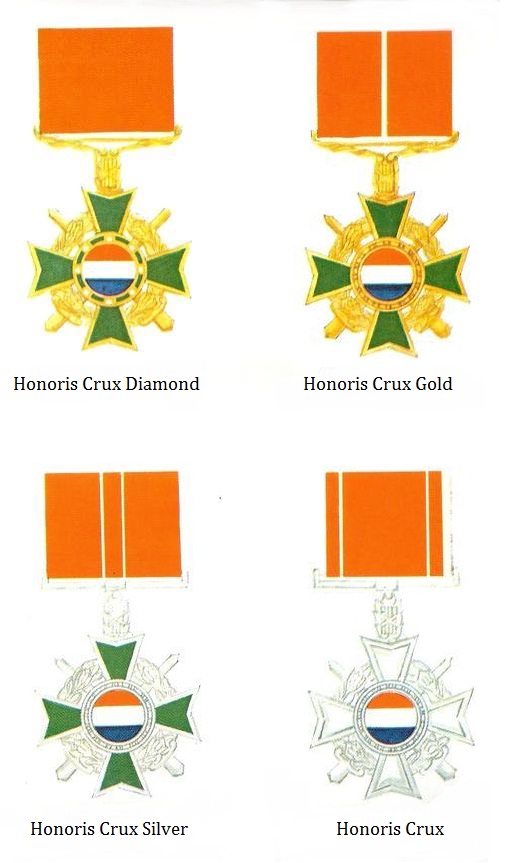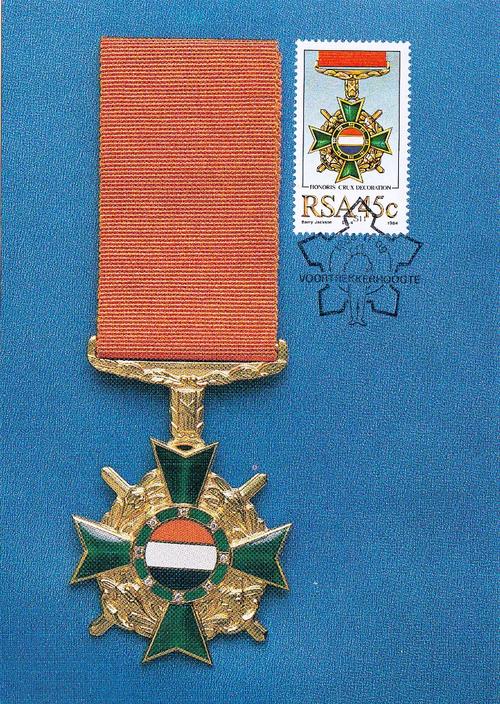This is the second of a two-part post on the Honoris Crux Decoration of South Africa. Part 1 recounted the institution of the Honoris Crux in the 1950s. This post focuses on the re-creation of the Honoris Crux in the 1970s.
By the early 1970s an escalating armed conflict was taking place in the region known as South-West Africa (SWA), now Namibia. Prior to WWI the territory had been a German colony, known as German South-West Africa. After the conclusion of WWI, the region was ceded to South Africa under the terms of a mandate from the League of Nations (the predecessor to the UN). Thus, SWA effectively became part of South Africa, being governed as a “fifth province” of the Union and later Republic. The system of apartheid that had developed in South Africa had also been legally and bureaucratically extended to SWA. Since the mid-1960s the South-West Africa Peoples’ Liberation Movement (SWAPO) had spearheaded an insurgency in the North as part of a struggle for independence. This threat was initially countered by the South Africa Police (specifically the highly effective counter insurgency unit called koevoet, or “crowbar”) and later by the South African Defence Force as the magnitude of the conflict escalated.
By 1973/74 it became evident that the large-scale involvement of the SADF in the so-called ‘Border War’ was poised to escalate drastically. The conflict had a profound effect on South African society as manpower, resources and, perhaps most importantly, sentiment was mobilised to counter the Cold War threat of communist expansion in Southern Africa. As with all instances of modern conflict, numerous sectors of society were organised in support of the war effort, including the media, religious and educational establishments, and civil society. As far as the armed forces were concerned, it was essential that an adequate range of awards were developed to acknowledge the service and sacrifice that would be required from the thousands of servicemen who would be conscripted into the conflict.
Thus, as part of an overhaul of the South African system of honours and awards, the HC was also reformed. The HC was reconstituted with a revised design and in four distinct classes, namely diamond, gold, silver and the ordinary class.

Sketches of the 1975 Honoris Crux award in its four classes, from the book Honoris Crux II, Ons Dapperes
As can be seen from the sketches above, the three senior classes of the award retained the green enameled Maltese cross of the original HC, with the junior class cross in white enamel. The eagles separating the arms of the original design were replaced with a wreath of Protea flowers (South Africa’s national plant) and a pair of crossed swords. The central roundel retains the South African national colours. The two most senior classes were produced in gold, with the highest class sporting eight diamonds embedded in the roundel border. The ribbon suspender is in the form of a bundle of rods, or fasces, which is a heraldic symbol of unity and authority. The four classes of award were also distinguishable by their ribbons of orange, either solid or with vertical white stripes.

The Honoris Crux Diamond depicted on a Republic of South Africa postage stamp from 1984
As anticipated, the expansion of the Honoris Crux decoration was matched by a marked increase in the number of awards, commensurate with the escalation of military operations by the SADF in South-West Africa and later Angola. Bearing in mind that only six of HC’s first incarnation were awarded between 1952 and 1975, a total of 201 HC (junior class), 27 HC silver, and 6 HC Gold were awarded between 1975 and 2003. The vast majority of these decorations were awarded between 1975 and 1988. Only two men were twice awarded an Honoris Crux; Captain Arthur Walker of the South African Air Force (the Gold class on both occasions) and Colonel André Diedericks of 1 Reconnaiscance Commando (HC in 1975 and HCS in 1985). The Diamond class was never awarded.
All four classes of the Honoris Crux, along with all the apartheid era honours and awards were finally abolished in 2003, and replaced with a new set of post-apartheid decorations in line with the political transformation of South African state and military after 1994. Thus, the institution, revision and eventual abolition of the Honoris Crux decoration in South Africa serves as particularly relevant example of the manner in which medals (as symbols of nation and state) are barometers of the particular national and political climate prevalent during particular periods of history in different countries. The Honoris Crux reflected South African ambitions of sovereignty and independence from Empire and the establishment of an own nationalist identity, the political consequences of this nationalism in the militarisation of the apartheid state during the second half of the twentieth century, and the dissolution of the award as a symbol of an unacceptable past in post-apartheid South Africa. This, as I have noted in previous posts, is why artifacts of military history are so much more than mere objects. They are virtual time capsules left over from earlier times that, to a lesser or greater extent shaped, symbolised, or recalled periods of which such artifacts may be our sole link to the past.
